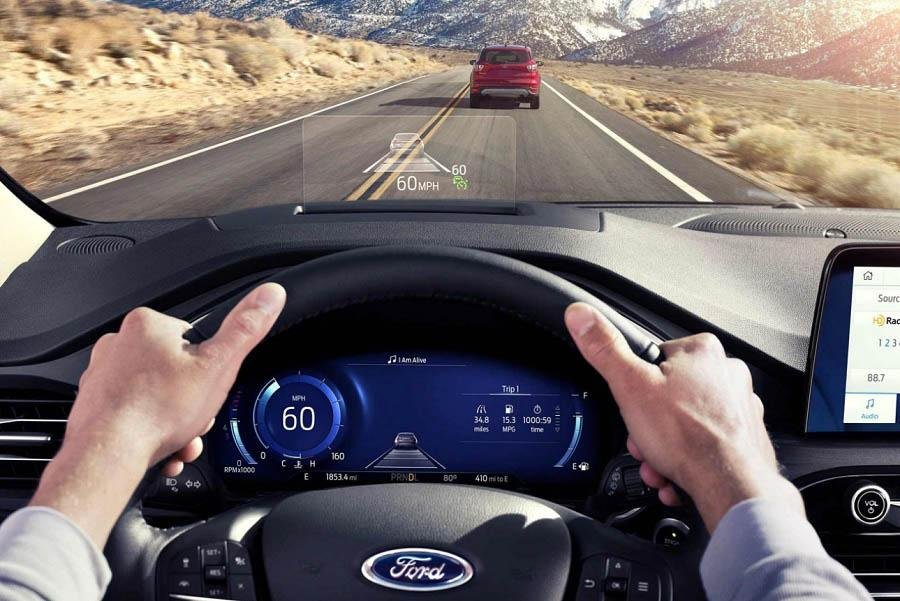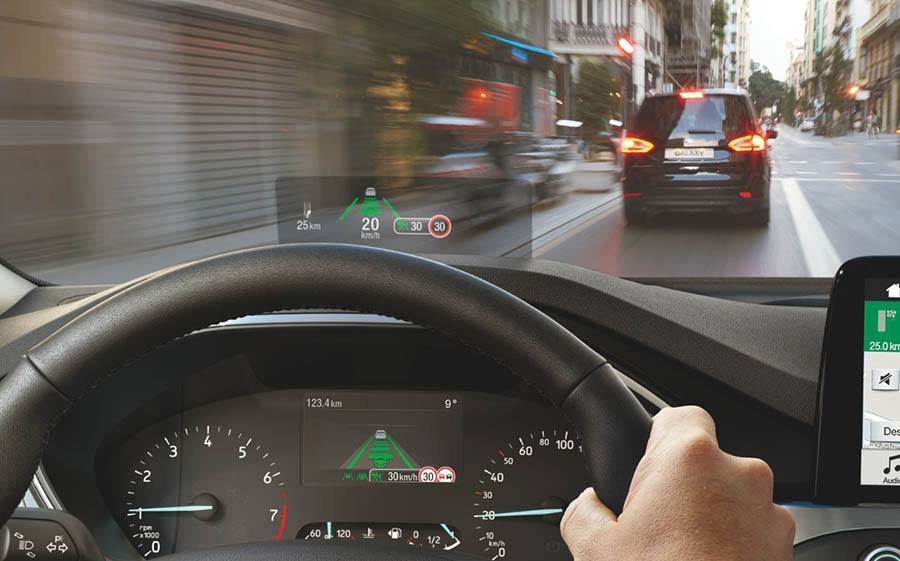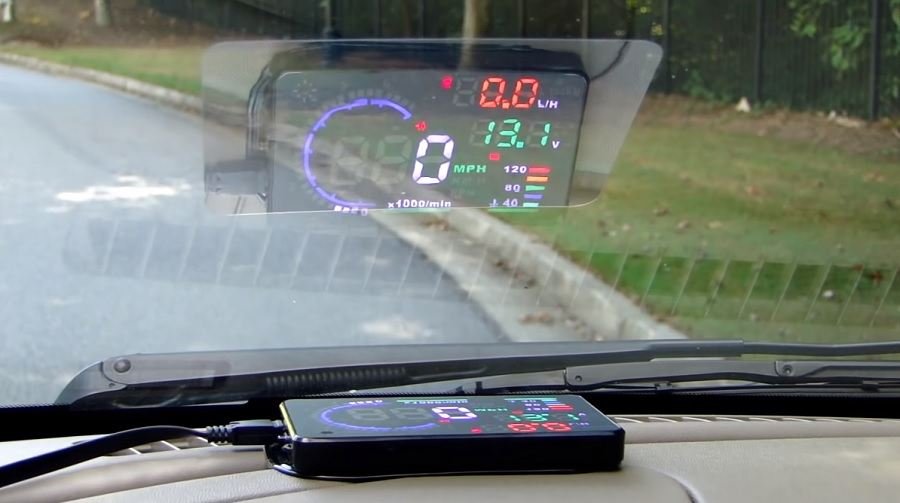A heads-up display (HUD) is an automobile technology that displays car data and information on the windshield of a vehicle in real-time. Heads-up displays are increasingly becoming part of newer cars, thereby abandoning older cars behind with the traditional analog displays, also known as Heads-down displays. Can You Retrofit Heads-up Display in older cars? If yes, what are your options, are there safety concerns, is it affordable, is it worth it, and what are the benefits?
Owners of older cars without OEM installed heads-up displays can now enjoy the same benefits. You can retrofit heads-up displays for most cars not equipped with factory-installed (OEM) heads-up displays. Third-party HUDs can be bought and installed from trusted dealers and manufacturers across the country. Cars with outdated versions can also be retrofitted with new and improved versions of HUDs.
There are different types of devices for retrofitting heads-up displays and car owners are choosing based on preference and convenience.
Table of Contents
Retrofitting Devices for Heads-up Display
Factory-installed heads-up displays are usually on-screen with a cutout on the dashboard for the projection of data on the windshield. However, you can find different types of HUD devices and modes of execution. This makes it possible for car owners to retrofit almost any type of car. You can also choose the heads-up device that best suits your needs and personality.
There are smartphone HUD kits that reflect car data on your windshield. The kit includes a HUD application, an anti-slip mat, and a projection screen. Your smartphone collects important car data like speedometer, car warnings, phone notifications, and navigation guide. A smartphone HUD makes it possible for everyone to enjoy the immense benefits of having a HUD.
However, due to its proximity to the windshield, your smartphone heats up faster, thereby quickly draining your battery. The smartphone HUD is also limited in functions and features.
A more comprehensive option is the Complete System Or Display Heads-up. These are the types of HUDs you’ll find in most factory-installed cars and at automobile dealerships. The factory-installed version comes already connected to your onboard diagnostic interface (OBD II). However, third-party HUDs require installation and manual connection to your car’s OBD II or WiFi. HUDs collect data using these connections.
Third-party HUDs come with a kit that includes an Image-receiving film that is placed on your screen and a box that both receives and projects car data. Third-party HUDs are efficient but should be used with caution. Always contact your car manufacturer before adding a new device to your car.
A simpler option, considerably better than smartphones, and as efficient as OEM complete system HUDs is the Dedicated HUD. It comes in various designs but functions similar to the Complete system.
Types Of Head-up Display To Choose From
The data displayed by HUDs are varied depending on the type and budget. Traditional heads-up displays show a limited amount of car data on your windshield. These include and are limited to car speed, navigation, warning notification, and navigation.
They are called simple displays and are a cheaper option. Although simple, this system will provide you with all the necessary details you need to move your vehicle from point A to point B without hiccups.
On the other hand, advanced cars are now incorporating Augmented Reality (AR) with HUDs. A massive technological advancement but costly. Augmented Reality Heads-up displays show car data and notifications from other connected devices in picture, video, and 3D format.
It promotes safety by presenting traffic data such as pedestrians, crosswalks, the speed of other vehicles, and potential collisions, to steer you clear of any danger.
Augmented Reality HUDs can identify objects and other road users with high efficiency. The floating arrows also make it easier for drivers to navigate traffic. They also feature eye-tracking sensors that bring the data to you, notwithstanding the angle of your head or the direction of your eyes.
How to Choose the best Heads-up Display
The functions and features of your heads-up display will determine your user experience and the level of assistance it’ll provide for driving.
A good heads-up display should provide crystal clear dials on your windshield. Sunlight affects the display of cheaper HUDs, thereby reducing their efficiency and use. However, advanced HUDs are programmed to automatically adjust to the surrounding light.
Rain and storms can also affect how you see the car data. Make sure the HUD you choose is efficient at displaying car data.
Another important factor to consider is the projection time. Advanced HUDs project car data in real-time, and can adjust in 300 milliseconds to fit your eye direction. HUDs that display traffic warnings, and navigation fast are more helpful at preventing collisions.
The type of connection can affect how fast a HUD system works to deliver car data and information. A stable WiFi connection is required for dedicated HUDs that use WiFi. Entering a no-network zone can render your HUD system useless. On the other hand, WiFi-powered HUDs deliver real-time data when in range.
Several HUDs can also connect to phones using Bluetooth to show mobile notifications such as emails, incoming calls, and text messages.
Lastly, look out for HUD systems with good heat resistance. You want your HUD to function properly even within hot areas.
How To Retrofit Heads-up Display
Here are the steps for adding a Heads-up display to your car.
You should first determine what connection your third-party HUD system requires for receiving and sending car data from the various car parts to your windshield. There are mainly two types of connection: WiFi and Onboard Diagnostic Interface.
If you’re using a Complete system or Dedicated HUD, then you’ll also have to place image-receiving filming on the windshield. Next, place the HUD box on your dashboard at the best angle that meets the driver’s vision.
To enjoy the best of HUDs, follow the HUD technology and retrofit according to the timeline of upgrades that suits your needs and preference.
Benefits Of Retrofitting Your Car With Heads-display
1. Safe Driving
Heads-on display indicates obstacles and objects on your path, carefully directing you through-traffic without risking collision. HUDs not only keep the driver safe but guarantees the safety of other road users. Retrofit your car with the latest and upgraded HUD to promote safe driving.
2. All your information in one place
Older cars are fitted with traditional analog heads-down displays that are only fitted with simple car data and real-time information. They provide limited dials, thereby forcing the driver to look elsewhere for more information. However, the digital and more advanced HUD shows all the necessary data and information in one place, eliminating the need to use foreign gadgets while driving.
3. Eye-on the road
The major benefit of the Heads-up display is eye-on-the-road. By displaying all the much-needed car data, and traffic information in one place and on the windshield, drivers no longer have to take their eyes off the road. Advanced HUDs also display incoming phone calls and notifications on your screen.
While some critics see it as another source of distraction, the consensus is that an on-screen notification prevents you from taking your eyes off the road to glance at your phone.
4. Reduced Fatigue
Moving your head in different directions can cause fatigue. Heads-on display keeps the driver’s head in one direction, thereby helping the driver consume energy.
Is Retrofitting Your Heads-up Display Safe
Retrofitting your car is generally considered safe. However, be sure to follow the manufacturer’s guide and manual, and also consult with your car manufacturer before installing a new device in your car.
There are numerous advantages to retrofitting a vehicle, including an enhanced driving experience. The difference in price and types also makes it possible for everyone to have one, notwithstanding their budgets. Always look out for the best brand HUD brands and choose the system that best aligns with your preferences.




